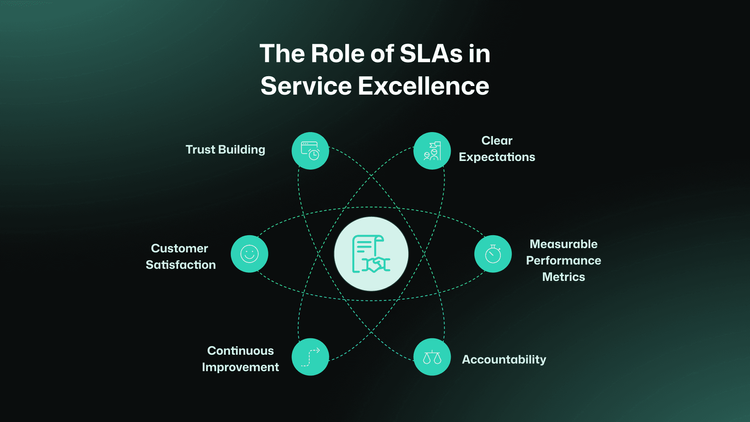Why Monitoring is Key for SLA Compliance and Customer Satisfaction

By defining performance standards, uptime expectations, and response times, Service-Level Agreements (SLAs) are the foundation of successful service delivery. These agreements are crucial for maintaining trust between service providers and their customers.
However, achieving SLA compliance requires more than good intentions. It requires businesses to implement server uptime monitoring to continuously track performance, identify gaps, and address potential issues before they escalate.
That is why effective website uptime monitor strategies ensure compliance and enhance customer satisfaction, making it a critical metric for successful business operations.
Benefits of Effective SLA Monitoring

The four pillars demonstrate why effective SLA tracking is crucial
Enhanced Customer Trust
Consistent and transparent monitoring builds a foundation of trust. When customers see that their service provider is proactively tracking performance and maintaining high standards, confidence in the partnership grows exponentially.
Proactive Problem Resolution
Effective SLA monitoring detects anomalies before they escalate into major disruptions. For instance, a managed cloud services provider might identify a spike in latency that signals an impending server issue, enabling preemptive action.
This approach reduces downtime, preserves business continuity, and ensures a seamless user experience. In the healthcare sector, proactive monitoring of critical IT systems can prevent delays in patient care caused by system outages.
Performance Optimization
Continuous monitoring provides invaluable insights into system performance, enabling data-driven improvements. By analyzing monitoring data, organizations can:
- Identify bottlenecks
- Optimize resource allocation
- Streamline service delivery processes
- Continuously enhance overall performance
Competitive Advantage
Organizations with robust SLA monitoring systems differentiate themselves in competitive markets. For instance, a telecommunications provider with near-perfect SLA adherence can market its reliability, attracting enterprise clients willing to pay a premium for guaranteed service.
Companies like AWS consistently highlight their SLA compliance to maintain their leadership in the cloud services market.
Financial Risk Mitigation
Preventing SLA violations reduces exposure to penalties and unexpected expenses. For example, an e-commerce company monitoring its payment gateway services can avoid costly disruptions during peak shopping seasons.
By ensuring stable operations, businesses protect their revenue and uphold their reputation, which is crucial during critical periods like holiday sales or product launches.
2. Challenges in SLA Monitoring
Here are some of the most common challenges in SLA monitoring:
Technical complexity
Organizations often face difficulties standardizing SLA compliance across diverse teams, tools, and geographies. For instance, a global enterprise managing SLAs for multi-cloud environments may struggle to unify monitoring metrics from different providers, leading to fragmented visibility.
Resource constraints
Legacy systems and limited budgets can hinder accurate SLA tracking. A mid-sized IT services firm, for example, may find it challenging to invest in advanced monitoring tools, leaving it vulnerable to SLA breaches.
Outsourcing or leveraging scalable monitoring platforms like Bubobot can help overcome such challenges.
Measurement accuracy challenges
Complex infrastructures involving multiple vendors can make SLA compliance measurements prone to inaccuracies. For example, a retail chain outsourcing IT and logistics may find it difficult to track where issues arise, creating friction in meeting SLA standards.

What challenges have you encountered in your SLA implementation?
3. How Bubobot Makes SLA Monitoring Worry-free for Your Organization
As a leading pingdom alternative, Bubobot is a powerful service monitoring tool designed to streamline monitoring and ensure businesses meet their SLA commitments.

Bubobot delivers a comprehensive service monitoring
1. Real-Time, Unlimited Monitoring
Bubobot offers 24/7 API health tracking to ensure uninterrupted operations. This continuous performance assessment provides instant visibility into system health, enabling immediate interventions when necessary.
2. Smart Alert System
Bubobot’s customizable alert system prioritizes critical issues and sends targeted notifications. By focusing on priority resolution workflows, teams can ensure fast response times and minimal customer impact.
3. Scalable Solutions
With flexible pricing and adaptability, Bubobot suits organizations of all sizes. A growing startup might start with a basic monitoring package and scale up as its customer base and infrastructure grow.
Conclusion
SLA monitoring transcends traditional compliance—it's a strategic approach to service excellence. By embracing robust web uptime monitoring practices and leveraging advanced tools, organizations can transform service delivery from a contractual obligation to a competitive advantage.
Let Bubobot Make Monitoring Worry-Free for Your Business.